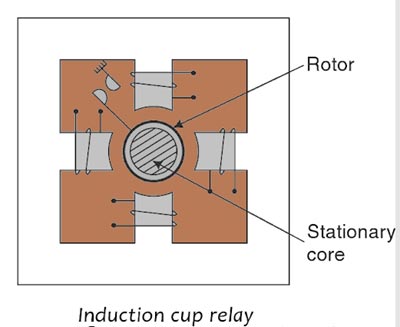Induction cup relay is operated due to changes in
Right Answer is:
Both 1 & 2
SOLUTION
The schematic arrangement of an induction cup structure is shown in Fig. It closely resembles an induction motor except for rotor iron is stationary, only the rotor conductor portion being free to rotate. The moving iron is a hollow metal cylinder or cup, which turns on its axis.

A stationary iron core is placed inside the rotating cup to decrease the air gap without increasing inertia. The spindle of the cup carries an arm that closes contacts. A spring is employed to provide a resetting torque. When two actuating quantities are applied, one may produce an operating torque while the other may produce restraining torque. Brake magnets are not used with induction cup-type relays.
The induction cup unit is a four-pole field structure with a very thin aluminum induction cup, which carries the movable contact. The opposite pole pairs are fed with any combination of voltage/voltage, voltage/current or current/current.
Two pairs of coils produce a rotating field which induces the current in the rotor. Torque is produced due to the interaction between the rotating flux and the induced current, which causes rotation. The inertia of the cup is much less than that of a disc. The magnetic system is more efficient and hence the magnetic leakage in the magnetic circuit is minimized. This type of magnetic system also reduces the resistance of the induced current path in the rotor. Due to the low weight of the rotor and efficient magnetic system its torque per VA is about three times that of an induction disc type construction. Thus, its VA burden is greatly reduced. It possesses high sensitivity, high speed and produces a steady non-vibrating torque. Its parasitic torques due to current or voltage alone are small. Its operating time is in the order of 0.01 seconds. Thus with its high torque/inertia ratio, it is quite suitable for higher speeds of operation. This type of structure is more efficient torque produced than either the shaded-pole or the watt-hour structure.
